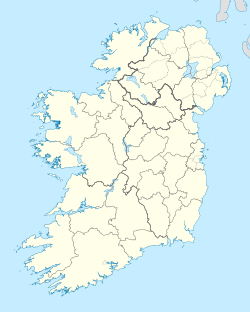Glashagarriff Bridge, Carhue
 Shown within island of Ireland | |
| Location | Carhue, County Cork, Ireland |
|---|---|
| Coordinates | 51°54′56.64″N 8°49′29.99″W / 51.9157333°N 8.8249972°WCoordinates: 51°54′56.64″N 8°49′29.99″W / 51.9157333°N 8.8249972°W |
| Type | Bridge |
| Site notes | |
| Public access | Yes |
Glashagarriff Bridge situated 2.8 km (1.7 mi) west of Coachford village in County Cork, Ireland is the meeting point of four townlands (Carhoo Lower, Carhoo Upper, Carrigathou and Coolnagearagh), two catholic parishes (Aghabullogue and Aghinagh) and two civil parishes (Aghinagh and Magourney).
Referred to as 'Clashgarriff Br.' on the 1841 surveyed OS map, and 'Glashagarriff Br.' on the 1901 surveyed OS map, the bridge spans the Glashagarriff River before it joins the River Lee a short distance to the south. Glashagarriff is an anglicised version of the Irish Glaise Gharbh (meaning ‘rough streamlet'). Smith in 1750, refers to the 'Glashigarriff' river.[1] At Cork Spring Assizes in March 1828, an application for a presentment was approved for the amount of £71 8s 8d, in favour of Charles Colthurst, John Bowen, John Haly and William Haly 'to widen Glashagorrive bridge on the road from Cork to Macroom. [2] The Ordnance Survey name book (c. 1840) gives various versions such as 'Clashgorrave', 'Closhagorrave', 'Closhagorriff' and 'Closhagorriv', and describes the river as rising out of the bogs of Doneens and Lyroe, flowing between the parishes of Aghinagh, Aghabollogue and Magourney, and falling into the River Lee to the south. An Irish Tourist Association survey of 1944 refers to the Glashagarriff river as having brown trout and freshwater eels, but no salmon angling, nor permit for trout fishing required.[3]
Many surviving bridges in mid-Cork are originally constructed of stone, arched in shape, and late eighteenth or early nineteenth century in date. Typical features include semi-circular arches and pointed breakwaters. Earlier bridges are often narrower, although some were widened at a later stage.[4]
See also[]
- Carhoo Lower (townland)
- Carhoo Upper (townland)
- Carhue House
References[]
- ^ Smith, Charles. The ancient and present state of the county and city of Cork (vol. 1, 2nd ed.). Dublin, 1774.
{{cite book}}: CS1 maint: location (link) - ^ Southern Reporter and Cork Commercial Courier, 27 March 1828
- ^ Murphy, C (1944). I.T.A. topographical and general survey. Irish Tourist Association.
- ^ Power, Denis; et al. (1997). Archaeological inventory of county Cork, volume 3. Dublin: Stationery Office.
External links[]
- Bridges in County Cork
